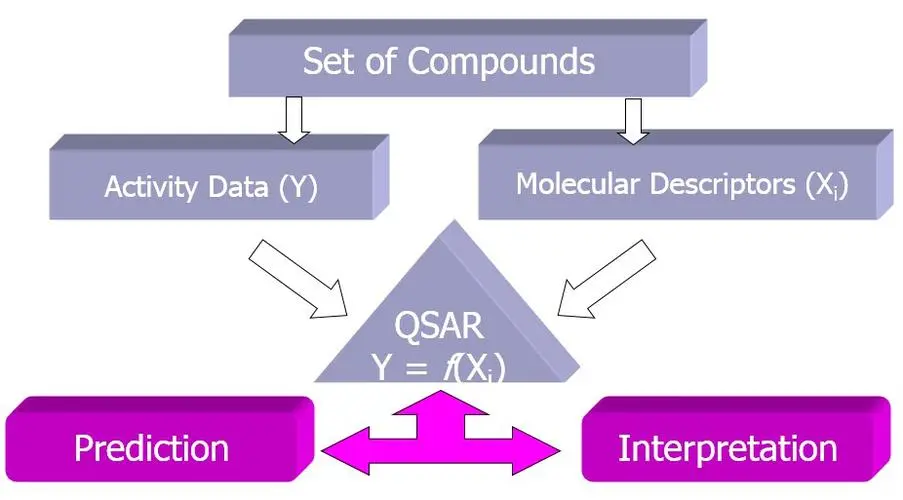



Business Inquiry
Global:
Email:marketing@medicilon.com
+1(781)535-1428(U.S.)
0044 7790 816 954 (Europe)
China:
Email: marketing@medicilon.com.cn
Tel: +86 (21) 5859-1500



In medicinal chemistry research, computer-aided drug design and structure-activity relationship research are both important contents. The structure of a compound determines its properties. For quantitative structure-activity relationship research, how to generate structural parameters that characterize molecular structure is the key to its success or failure. Structural parameters are structural descriptions that express molecular structural features. Starting from molecular structure, using quantitative structural property correlation models to estimate and predict drug activity and biological toxicity is of great significance for modern drug research.

Quantitative structure and activity correlation (QSAR) research is how to quantitatively predict the chemical properties of a substance from its chemical composition and structure. It was developed to meet the needs of rational design of biologically active molecules. This research is useful for the design and screening of significant biological activities. Drugs and elucidating the mechanism of action of drugs have important guiding roles. In pharmaceutical research, the study of quantitative structure-activity relationship is an important subject of medicinal chemistry.
The proposal of the structure-activity relationship expression of linear free energy relationship (LFER) marks the beginning of the era of quantitative structure-activity relationship. At that time, only a few chemical parameters such as the electronic effects of substituents, hydrophobic effects and stereo parameters could be quantified. According to the descriptions on the Internet, currently chemists are looking for the following four main parameters that characterize molecular structure information. One is based on the molecular formula and experimentally determined empirical constants, such as physical and organic chemical parameters such as electronic effects, steric effects, and hydrophobic effects. With the rapid development of theoretical chemistry and computers, there has been Calculated parameters, such as topological parameters, spectral parameters, molecular electrostatic potential parameters, quantum chemistry parameters, etc.; the third is interaction parameters and some special description parameters such as Free-Wilson latent element parameters, and three-dimensional molecular structure parameters; The fourth is various topological parameters deduced from the two-dimensional topological structure of molecules, such as molecular connectivity index.
At present, quantitative structure-activity relationship research has become a powerful tool for studying the relationship between physical and chemical properties and biological activity of substance molecules. It is used to predict the biological activity, structure and selective action of compounds, pharmacokinetics, and help understand the mechanism of action of drugs. And some achievements have been made in predicting receptor images. Medicilon has rich experience in medicinal chemistry, and efficiently promotes customers’ drug research and development projects, prompts new drug processes to enter candidate determination and new drug clinical research earlier, and effectively helps customers control new drug development costs.
The structure-activity relationship research is an important content of medicinal chemistry research. The mathematical model established by molecular structure parameters can provide important information for new drug screening. For example, researchers have established a quantitative prediction model for the permeability of the blood-brain barrier, and determined the main influencing factors of drugs passing through the blood-brain barrier [1]. The researchers selected 190 compounds as the data set, using a combination of principal component analysis and multiple linear regression analysis, and using 10 molecular structure parameters to establish a mathematical model. The results of the study found that the model established by the researcher showed a certain degree of reliability and predictability. At the same time, molecular parameters that have a greater impact on the permeability of the blood-brain barrier were determined. These parameters and the built model can help guide further New drug screening and development.
For example, in the study of using theoretical parameters to predict the transdermal permeability of drugs, some researchers use the semi-empirical molecular orbital AM1 method to calculate the structural parameters of the drug molecule, and use the stepwise multiple regression analysis method or the BP neural network method to establish the transdermal The correlation between permeability and these structural parameters [2]. The results of the study found that the permeation parameters (kp) of 22 model drugs through human skin in vitro and the permeation ratio (R, permeation/non-permeation) of 17 model drugs through human skin in a certain period of time were calculated The value agrees with the measured value. Therefore, theoretical parameters are used to predict the transdermal permeability of the drug.
Through the parameterized characterization of molecular structure, the molecular structure of a compound can be represented by an appropriate descriptor. In-depth understanding of the relationship between molecular structure and function in the field of drug discovery can help overcome the waste caused by blind exploration and minimize the cost. To obtain high-performance chemical entities to develop new drugs.
[1] Prediction model of blood-brain barrier permeability based on molecular parameters [J].
[2] Using theoretical parameters to predict the transdermal permeability of drugs[J].